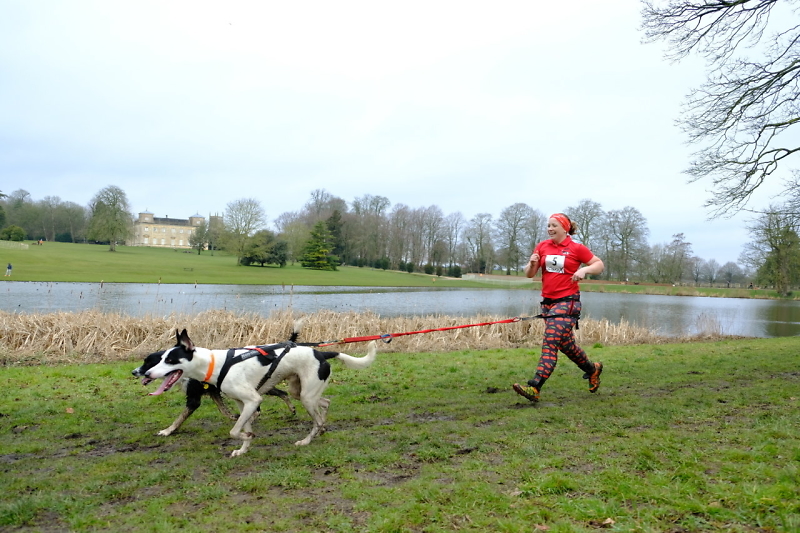
The Harness
If you are going to expect your dog to pull any weight when running, then it is your responsibility to make sure that your dog is in the most suitable harness which allows your dog the best range of movement to suit their shape and running style. Pressure put on the neck (a very sensitive area) with your dog pulling is something that should always be avoided, so ensuring their comfort and safety should be a top priority.
In general – if your dog is a strong puller choose a long or longer ‘style’ harness that distributes the pull along the length of the dogs’ body
In general – if your dog is a leisurely/occasional/non-puller choose a shorter style harness so the harness sits no further than the mid-back of your dog
Any harness which you chose for your dog should be checked in 5 specific areas to allow a full, free range of motion when the dog is running.
1. Neck – the harness should not cause any pressure on the throat of your dog and sit down near to the prominent breast bone on the front of your dogs’ neck
2. Shoulder – the harness should leave the large shoulder bone (known as the scapula) free to swing forwards and backwards. This is incredibly important because the fore limbs of the dog take 60% of the dogs weight under normal loading and the shoulder has numerous muscles, ligaments and tendons which activate to allow your dog to move forward. If any of these muscles are restricted, an imbalance can occur, leading to problems further down the line for your dog.
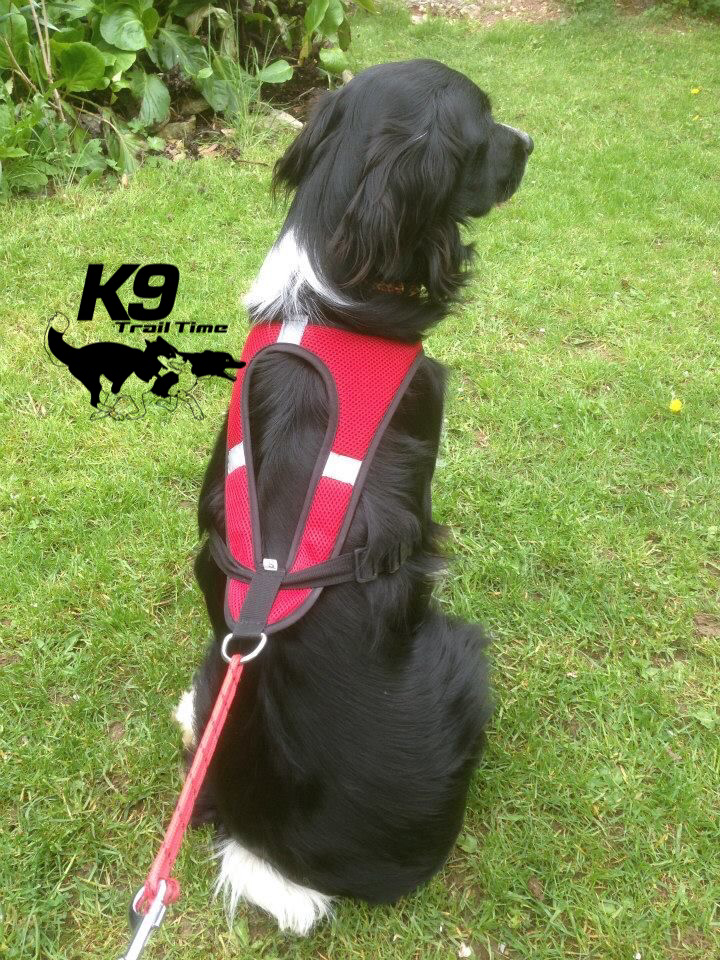
3. Behind the front legs – the harness should not dig in behind the front legs but again leave the limbs free to move, to avoid discomfort and also any future issues as above.
4. Ribs – the harness should not come too far along the dog’s body in the rib area, if the harness straps are on the side of the dog behind the last rib, then this can pull up into the dogs’ stomach and cause discomfort for your dog.
5. Hips (only if you’re using a long harness for stronger pulling dogs) – a dog is propelled forwards from the power generated in the hind legs and this power is transferred through the hip and lower back joint, known as the sacroiliac joint. If the harness restricts this joint, then it can cause problems.
So your dog needs to be able to move freely top to tail!
“It is your responsibility to make sure that your dog is in the most suitable harness which allows your dog the best range of movement to suit their shape and running style.”
The Belt
Belts for canicross have always been called waist belts but they should all be worn sitting on the hips, not high around the waist, even if you have one of the wider padded belts. This is to prevent the force of your dog pulling from being anywhere near your lower back.
Sometimes companies differentiate between the styles by referring to some of the belts as ‘hip belts’ but they should all be worn on the hips to avoid any pulling pressure on your back. The belts should probably just be called ‘belts’ to avoid any confusion!
A canicross belt is as individual for a person as a harness is for a dog, so make the decision based on what your requirements are.
To help choose, identify what is most important to you in a belt:
1. Do you need a pocket? Remember you can carry things like water, your phone, poo-bags and keys in a separate way and not rely on having a big pocket on your belt, as the type of belt that suits you best might not have pockets.
2. Leg straps? Leg straps help to keep the belt in place, not so much from riding up and down but more to prevent the belt from twisting to one side or the other. Some people think leg straps will chafe and usually if the belt is fitted correctly, this is not an issue. The belts have been designed by people who have been doing the sports for years and understand the needs of the belt, so have positioned the leg straps so they work to keep the belt in place without chafing.
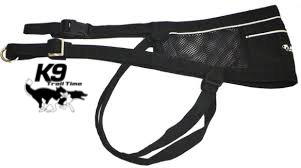
3. A fixed or sliding attachment point? The fixed attachment point gives you more control as your dog can’t move quite as far side to side on the belt, the sliding attachment point means if your dog is strong and pulls around a corner, you have a more gentle experience than if your line is fixed in the middle of the belt. It might not make any difference to you at all but these are things which influence the decision people make when choosing a belt for themselves.
4. Lightweight or more structure? Lightweight belts can look like there’s not a lot of substance to them and more structured belts can look more comfortable when you consider that your dogs’ pull will be directed through the material of the belt. However, all canicross belts have been designed so that they are providing a way for the dogs’ pull to be distributed and so lightweight options are just as adept at doing this as a more padded belt.
Most of the belts available are ‘one size fits all’ however some styles are sized and tend to have a maximum circumference which states waist but remember belts function better positioned on the hips, so ensure that is the measurement you base your sizing on.
Bungee Lines
Line length – this is usually a stretched length which means unstretched they are approx 30 cms shorter with a webbing line.
The bungee line is what connects you to your dog via your belt and your dogs’ harness, it needs to have a section of elasticated bungee within it to help absorb the force of your dogs’ pull, particularly if they pull strongly or speed up if they see something exciting!
Most standard canicross lines are 2 metres when stretched, so if you see Standard, CC or Canicross in the description they will be 2 metres stretched, although (confusingly) depending on the product sometimes they are the short version if there’s nothing shorter!
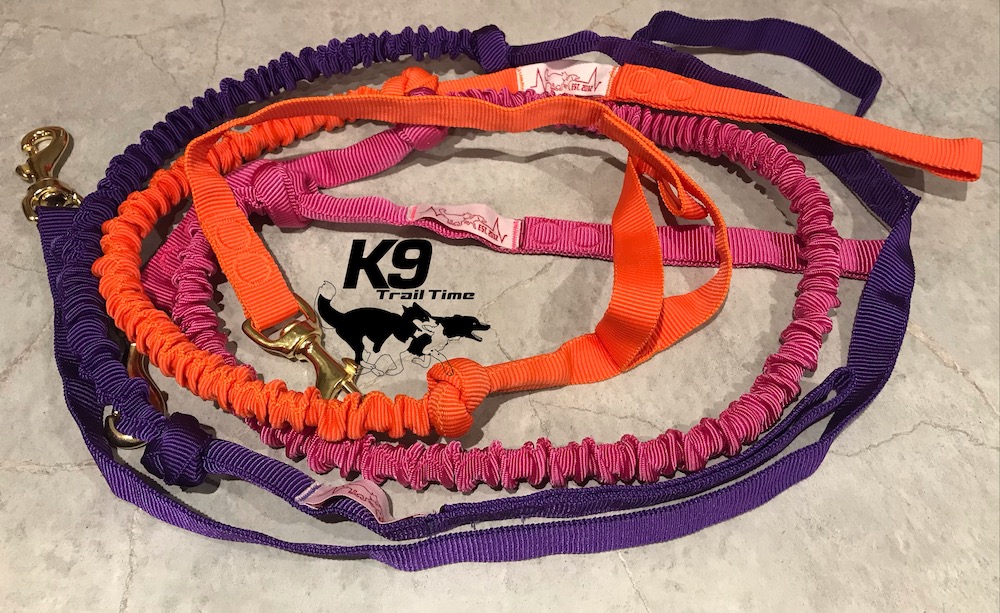
Short lines are known as Parkrun lines (because they came into existence to meet the Parkrun requirement of a short line) and are generally 1.2 metres stretched, so if you see Short, Parkrun or PR in the description, then they will be 1.2 metres stretched.
Some brands now offer a Mid-length option too which stretches to a length of 1.6 metres for those who find the Standard length too long and Short length too short.
Longer lines such as Bikejor lines will be anything from 2.5 – 2.8 metres stretched and will be described as Long, Bikejor, Scooter or something to that effect. These can still be used for canicross but many find them too long for regular use and would be too long for racing.
Line Clips
This is what attaches to your dogs’ harness. Most line clips will be brass trigger clips and this is the standard clip, easy to hook on and take off any ring or cord on your dogs’ harness. These are the most suitable clips for every day and regular use.
Some lines have a twist-lock carabiner, which means there is a gate that opens and a screw lock which will automatically (not if it’s got mud and dirt in the mechanism) close and twist around when attached, so your dog cannot pull the clip open by catching it on something. You might want to use these if your dog has the potential to escape or you want a bit more security, they are lightweight and no heavier than a normal clip.
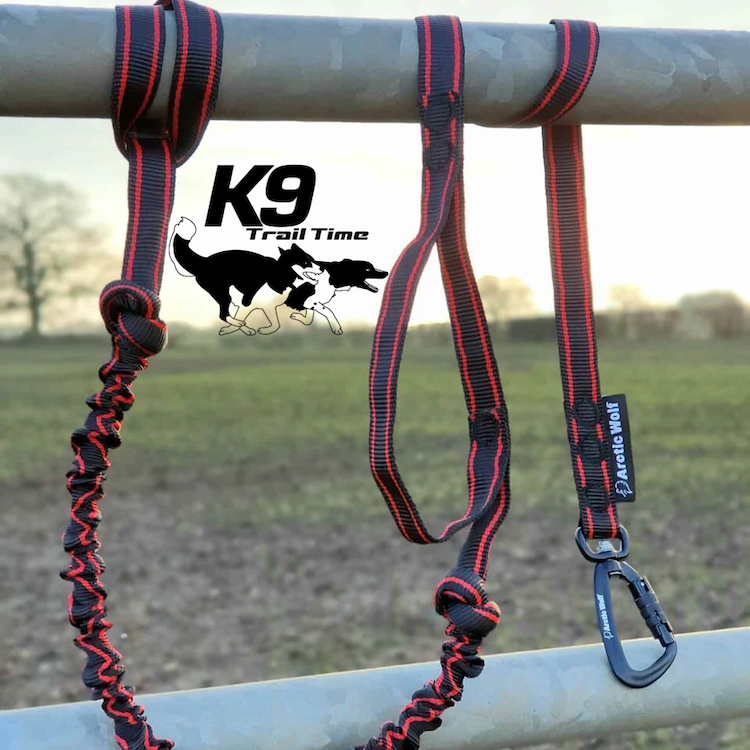
Handles – some lines have handles on them to grab if you need to
The lines with handles will either have an ‘external’ grab handle which is an additional webbing loop sewn on to the line or an ‘internal’ handle which forms part of the line and you slide your hand in to grab. Handles can be situated around the halfway point on the line or further down near the clip to attach to your dog.
To attach to you – how the lines attach to your belt
Most of the lines will have a handle at the end to attach to your belt and you can either loop the line through on itself or use a carabiner to attach the line to use if you need a quick release. Some belts also have carabiners or a set up at the front of the belt so you can attach your line and have a quick release.
Our Expert
K9 Trail Time stocks a wide range of products that we have tried and tested ourselves, so you can be sure they are fit for purpose. If you need any advice on choosing specific canicross equipment for you and your dog, please do contact us at info@k9trailtime.com
